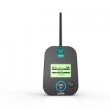

From smart thermostats to fitness trackers the race is on for companies to put out the next big connected product. However, during this foundation stage it’s essential that the companies developing or selling IoT technologies don’t take shortcuts when it comes to security protocol and ensure that the products they are selling do not pose any risk to the user’s security, writes Thomas Fischer, the principal threat researcher at Digital Guardian. (more…)
August 10, 2016
Posted by: George Malim

APC Smartwave has added a new range of Field Test Devices from French manufacturer Adeunis RF to its comprehensive range of integrated IoT components and solutions. (more…)
August 8, 2016
Posted by: Avadhoot Patil

The Internet of Things (IoT) could have profound implications on our everyday lives – including our everyday safety – but there needs to be much greater collaboration between vendors, partners and customers to make it a reality, writes Dermot O’Connell, the executive director and general manager for OEM Solutions at Dell EMEA. (more…)
August 5, 2016
Posted by: George Malim

Many IoT applications require local intelligence in the gateway. To meet this need, Systech Corporation is now including SysSCRIPT™ Lite at no cost to its entire line of SysLINK IoT hardware gateways. (more…)
Posted by: Avadhoot Patil

If you think about it, hackers are canny, writes Adrian Crawley, the regional director for Northern EMEA at Radware, in the second part of his blog. (more…)
August 4, 2016
Posted by: George Malim

Hacker is a dirty word. It conjures up images of someone locked in a dark basement coding into the night and unleashing digital horrors on the unsuspecting, writes Adrian Crawley, the regional director for Northern EMEA at Radware. (more…)
August 3, 2016
Posted by: George Malim

Homes, hospitals, shopping centres and department stores, airports, large manufacturing plants – all have a growing volume and variety of connected devices that rely on Wi-Fi to communicate and function, writes Areg Alimian, the senior director of solutions marketing at Ixia. (more…)
July 29, 2016
Posted by: George Malim

The wow factor has played a major role in the public’s perception of the Internet of Things or IoT, writes Jonathan Duffy, the EMEA managing director of Netclearance. There’s something about the idea of a world made up of objects all linked together that resonates with people, so it is understandable that there is currently a lot of hype surrounding it. (more…)
July 28, 2016
Posted by: George Malim

IoT devices are often built to strive for efficiency. If you remove the huge, power hungry screen of a mobile phone the energy consumption will naturally be lower, write Abilio Marques, a senior software engineer, and Bettina Rubek Slater, the chief operating and chief marketing officer of Pycom, in the second part of their blog. (more…)
July 21, 2016
Posted by: George Malim

Infosec pros have spent the past decade fighting a rising tide of both more users and more devices connecting to enterprise resources while at the same time trying to decrease the attack surface — that is, trying to shut down as many points of access as possible, writes Joe Schorr is director of advanced security solutions at Bomgar. (more…)
July 18, 2016
Posted by: George Malim